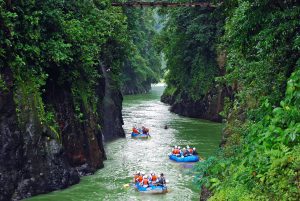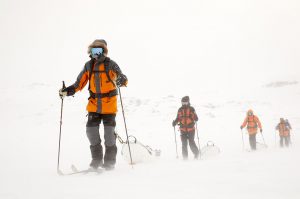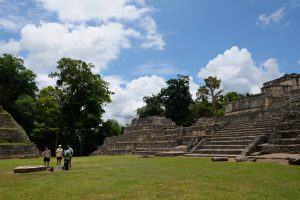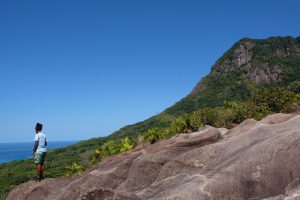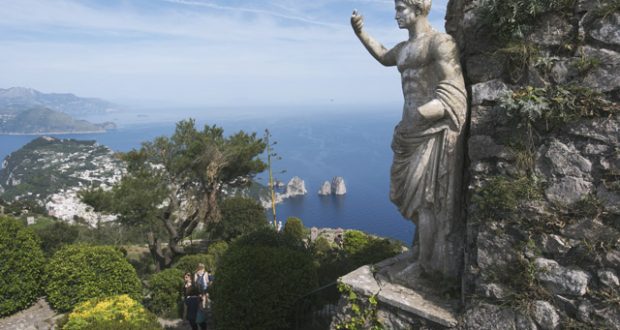
View of the Faraglioni from Monte Solaro. Image: Tristan Bejawn
Famed for its decadence and beauty since the 1960s, Italy’s ultimate hideaway is no longer so hidden. But with its wild cliffs and spectacular villas it’s easy to forgive Capri for being so popular
It’s not a big knife that Antonio is placing between my toes, but seconds previously I saw it slice through leather as if it were butter — so I’m concerned when two rambunctious children decide to start a flailing dance routine just behind him on the tiny shoe shop floor. “Has this ever gone wrong?” I ask, as a tot pirouettes towards us. “Never,” Antonio answers, whipping away the chunky, wooden-handled scalpel and removing a leather sole, now marked with little incisions, from beneath my foot.
It was, of course, a stupid question. Like his father, Capri’s famous sandal-maker, Costanzo — whose tools he still uses — Antonio has honed shoe-making to a fine art. And it’s serious business — after all, the shop’s Roman-esque sandals, which once graced the feet of Clark Gable and Sophia Loren, now incorporate glossy coral and turquoise stones and command hefty, three-figure price tags — but not serious enough to prevent an impromptu family party in the shop’s premises.
Antonio is back at his cobbler’s workbench, which is pitted with grooves for tiny golden nails and cluttered with gaudy gems. He’s snipping straps and punching eyelets in a frenzy of motion, using a range of instruments that wouldn’t have looked out of place in a medieval torture chamber. Behind him hangs his father’s photograph. “Times have moved on here; Capri has changed, the customers have changed,” Antonio says, over the children’s chatter. “Before, my father would take measurements, then make every shoe from scratch. I’ll still take some special orders, but since Capri now attracts so many day-trippers, the soles are ready-made in our factory in Naples. It’s all about speed.” With a final flourish — and only 15 minutes after I walked in off the breezy, sea-facing street — two elegant, made-to-measure, gold T-strap sandals are complete. “Presto,” he intones, ushering me to a stool. He secures the straps around my feet and for a moment I feel like Cinderella; never has a shoe fitted so well.
Back outside, I meander downhill through streams of shoppers to the heart of Capri town — Piazza Umberto I, or the piazzetta as it’s known locally. An ancient, lemon-coloured clock tower and an imposing whitewashed church dominate the square, which is filled with cafes — each hosting a small troupe of tourists sipping coffee in wicker chairs beneath coloured awnings. The crowds notwithstanding, it’s a charming scene that seems quintessentially Mediterranean: cream-jacketed waiters swoop between tables with flashing silver trays, and from the plaza’s antique arches (the square was once a fish market) emerge glamorous figures, both male and female, dangling bags from the designer shops of the adjacent Via Camerelle.
I, on the other hand, make a beeline for the famous Gelateria Buonocore, tucked away on Via Vittorio Emanuele, guided largely by the scent of freshly toasted waffle cones. It’s a decision that takes some minutes but I opt for three generous scoops of ‘fantasia di Capri’ — a flavour taken from the island’s delectable torta Caprese (chocolate and almond cake).
In search of a quiet spot to enjoy my ice cream, I climb a shallow staircase beside the church, past a collection of wooden herb boxes, and enter an empty alley that twists past wayside shrines on to a promenade of elegant villas, magenta blooms and lemon boughs escaping over garden walls. Hand-painted ceramic signs lead me to Belvedere di Tragara, a sun-catching terracotta terrace built out over vertical, slate-grey cliffs. From here, the Faraglioni — a trio of titanic sea stacks — punctuate the seascape like a monstrous ellipsis. It’s a soul-quenching view — the type that makes one question ever returning to a city.
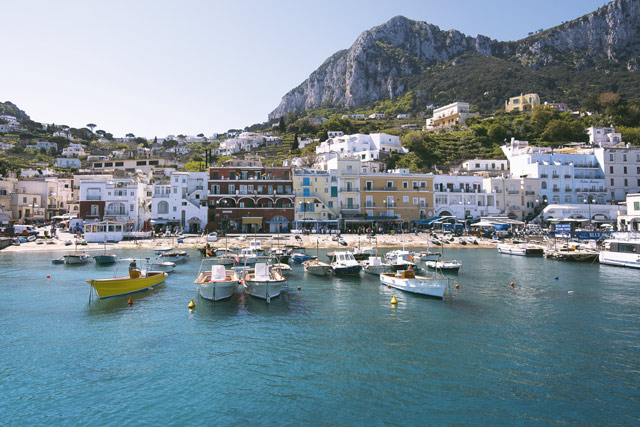
Marina Grande. Image: Tristan Bejawn
Boatmen’s chorus
The next morning, I’m gazing up at the same towering rocks as our boat bobs through a natural portal in the central stack. The rust-coloured veins in the stone pop against the blue backdrop — a binary world of sea and sky stretching towards Africa. The largest of the Faraglioni is the sole habitat of the blue-tinted lizard — something of a mascot for Capri.
As our boat circles Capri’s cliffs and bays, the guide points out the most lavish villas, scenic restaurants and distinguished hotels, and signals lofty, tumbledown Napoleonic fortinos and Roman ruins half-hidden by olive-green domes of foliage. From a rocky outcrop beside the small beach of Marina Piccola a pair of sunbathers wave to us. Open grottos pass by: yawning mouths of white stalagmites alternating with low, shady mazes of arches over pellucid waters, perfect for swimming.
It’s easy to see why the first Roman emperor, Caesar Augustus, made the island his private playground and why his successor, Tiberius, retired here in AD 27, building the grand Villa Jovis, the ruins of which can still be visited on the eastern tip of Capri. For years, the island’s charms were the preserve of, by turns, peasant farmers, marauding Ottoman pirates and Napoleon’s Grande Armée, until, in the late 19th century, it began attracting artists, Russian intellectuals and wealthy homosexuals escaping persecution. Then Brigitte Bardot and Jackie Onassis came to town in the 1960s, setting a precedent for lavish Capresean holidays that’s still observed by A-listers today. The night before, I’d popped into the infamous live music venue Taverna Anema e Core (where it’s considered rude not to dance on the tables) and gawped at recent snapshots of Mariah, Beyoncé, Naomi and Leonardo tacked on the walls.
The boat steers into a crowded cove, dodging smart, lacquered vessels before dropping anchor. A number of coloured rowing boats weave towards us, the oarsmen signalling to us passengers to jump aboard. I pick one and clamber in, inelegantly landing on the floor. Which is useful, as Claudio, the rower, paddles us towards a very low cave entrance — the opening rising less than 3ft above the tide.
“Get down,” he shouts, tugging hard on a rope emerging from the hole and throwing himself backwards onto the floor of the boat. It all happens so fast: the boat shoots into the darkness and, as my eyes adjust, I see we’ve emerged into a large cavern — the legendary Blue Grotto. The water is glowing, like liquid emeralds, throwing blue ripples of light onto the ceiling and walls. As more boats barrel in behind us Claudio, now standing, dips the oars and propels us around the grotto, leading the other boatmen in the inevitable chorus of Volare, oh oh. Cantare, ohohoho. Nel blu dipinto di blu…
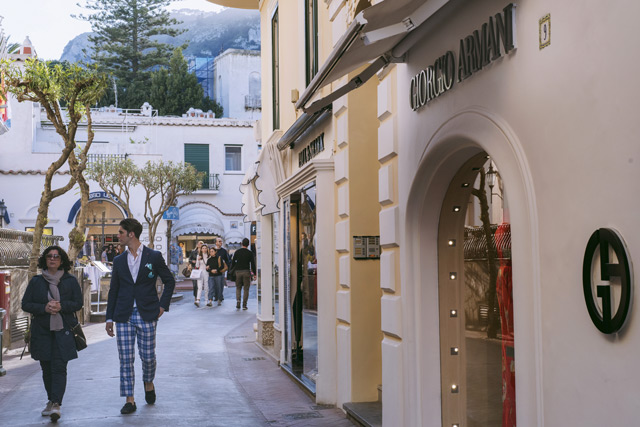
Shoppers on Via Camerelle. Image: Tristan Bejawn
Lucky lizards
For residents of hilltop Anacapri, the island’s sleepy second settlement, Sunday morning is the time to pop to mass, scoop up some groceries or catch up with neighbours in the elegant Piazza Armando Diaz. The streets are humming when I exit the Church of San Michele; the nave of which is given over to a wonderfully garish 18th-century majolica floor mosaic of Adam and Eve’s expulsion from the Garden of Eden, painted by someone who’d clearly never seen an elephant first-hand. I find myself sympathising with the woeful expressions of the first man and woman — my ferry back to the mainland is booked for the afternoon. I, too, face eviction from paradise.
Back in the main square, Piazza Vittoria, tourists are arriving, descending from nippy yellow buses or stepping, windswept, from a white, open-top stretch taxi. Some head for the chairlift, which whisks them over farms and orchards to the top of Monte Solaro, while others browse the shops.
I’m drawn to Eureka Ceramiche d’Arte, where, among the glazed dishes, urns and souvenir trinkets, I find an eye-catching stack of blue lizards; it seems you can take home one of the mysterious denizens of Capri’s outlying rocks, albeit in pottery form. “In Capri, we put these statues by our front door,” says the owner, emerging suddenly from behind a large vase. “Tap it as you leave every day — it’ll bring you good luck,” he adds, placing one in my hands. “No charge, signorina.”
I’ve just time to stroll to Villa San Michele — the actualised dream of Axel Munthe, a young Swedish physician who visited Capri in 1885 and, very sensibly, decided to stay. He built his house in an idyllic spot, on the ruins of a Roman palace: a wide, planted loggia leads from the airy main building, filled with Etruscan curios, to a restored medieval chapel that looks out across the Bay of Naples to the mainland. Vesuvius looms above the Sorrentine Peninsula as a hazy pyramid of mauve and the sea appears crisscrossed by pale trails, the ghostly wake of dawn fishing boats.
Near the end of his life, Munthe wrote a book about his youthful adventures in Capri, The Story of San Michele, which I pick up in the gift shop. It’s an entertaining compilation of comical anecdotes, florid odes to the island’s beauty and colourful stories about the construction of the villa. Over five summers, he and a group of local men transformed the site, which, as he tells it, spat out the most amazing relics: marble sculptures and column fragments, sunken frescoed chambers and a crypt with two sarcophagi. Over the past century, the island has given up most of its secrets, and its charms are common knowledge — but I recognise so much of modern Capri in Munthe’s descriptions. In the face of fame and development, the island’s mystique is potent and enduring.
Published in the Jul/Aug 2016 issue of National Geographic Traveller (UK)





